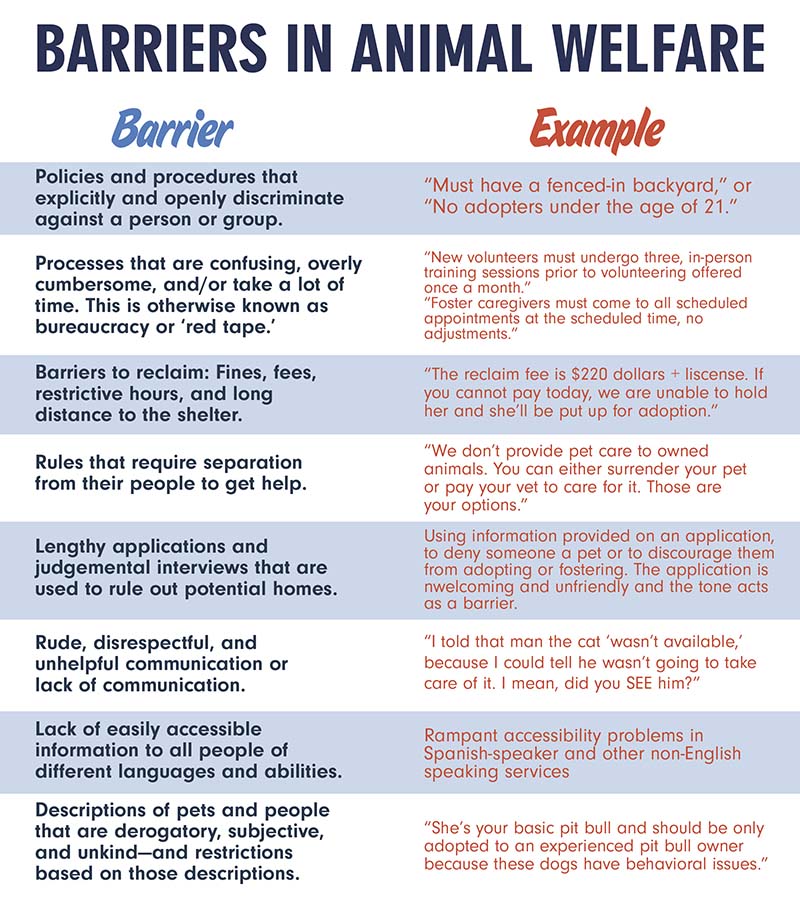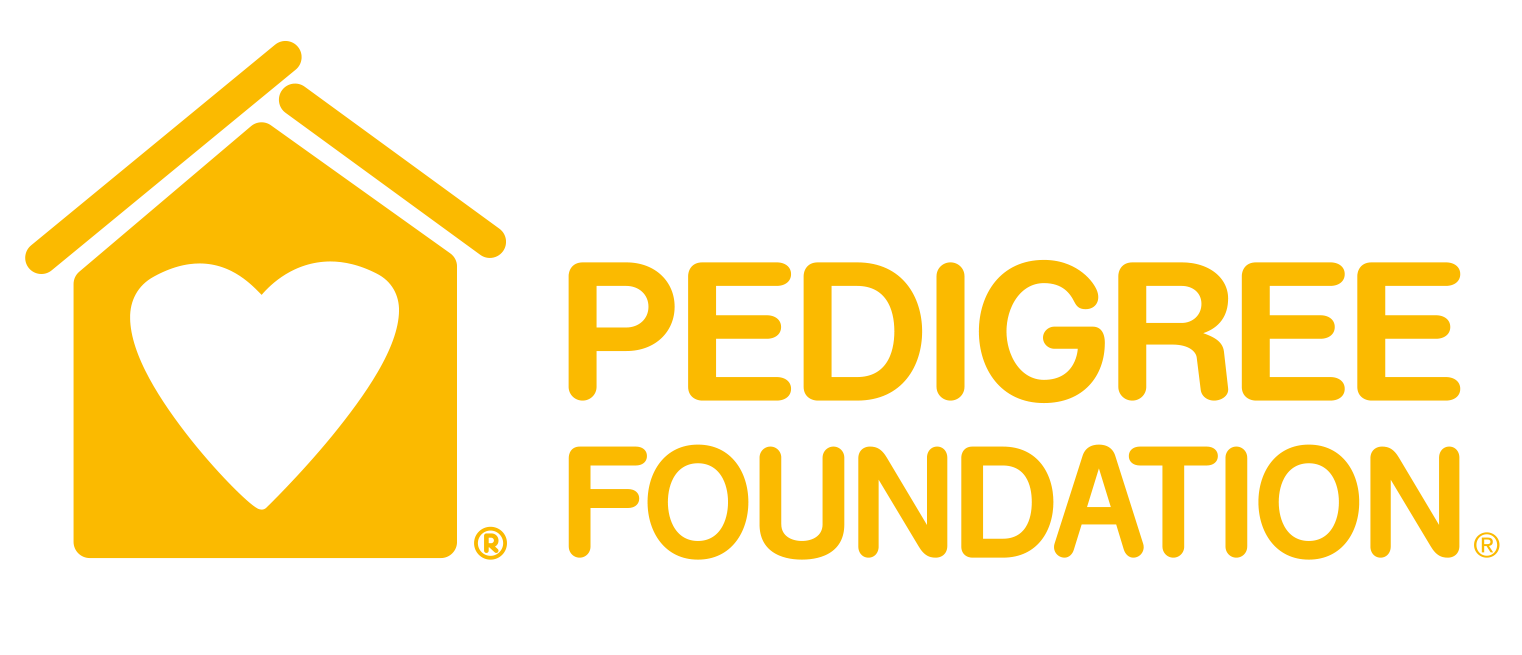“Get rid of barriers” is one of the most commonly uttered phrases in animal welfare and for good reason.
Barriers get in the way of us helping pets and people, and they prevent us from truly engaging our whole communities. Barriers are, by their nature, discriminatory. They disproportionately impact poor people and other marginalized groups.
They also stop adoptions and foster placements. And in doing so, they slow down the entire system. Animals don’t move quickly through the shelter system, and that leaves less space for incoming cats, dogs, and other pets.
How do these obstacles show up and what can we do about it? These are the questions we’ll tackle in this blog.
What are Barriers?
Barriers are obstacles that cause harm by standing between shelter pets and loving homes. They come in many shapes and sizes, and are often veiled in terms such as “screening,” “counseling,” “checks,” and “approval.”
An important thing to know about barriers is that our system is set up to invite them in. In the same way you can’t sweep your floor once and expect it to never get dirty again, you cannot get rid of a barrier and expect it will never reappear.
As staff and volunteers turn over, and new policies and procedures are written, barriers will rear their ugly heads. It’s up to us to pay attention and get the broom out when they do.
Barriers in Animal Welfare Fall into Roughly Eight Categories
1. Policies and procedures that explicitly and openly discriminate against a person or group.
For example, “adopters must have a fenced-in backyard,” or “no adopters under the age of 21.”
2. Processes that are confusing, overly cumbersome, and/or take a lot of time.
This is otherwise known as bureaucracy or red tape.
These examples might sound familiar: “New volunteers must undergo three in-person training sessions prior to volunteering, and sessions are offered once a month,” and “Foster caregivers must come to all scheduled appointments at the scheduled time and no adjustments can be made to the schedule.”
3. Fines, fees, restrictive hours, and long distances to get to the shelter.
These types of barriers impact everyone—especially people reclaiming lost pets. The more difficult and expensive it is to reclaim an animal, the fewer people will be able to do so.
Hearing this—“The reclaim fee is $220 and you’ll have to purchase a license on top of that. If you cannot pay today, we are unable to hold her and she’ll be put up for adoption.”—may be the difference between splitting up a family, or a lost pet going back home.
4. Rules that require pets to be completely and permanently separated from their people to get access to veterinary services or other help.
E.g., “We don’t provide pet care to owned animals, whether or not you can afford it. You can either surrender your cat or pay your vet to care for it. Those are your options.”
5. Lengthy applications that are used to rule out potential adopters and fosters.
We see this much too often: Animal welfare organizations using information provided on an application, to deny someone a pet or to discourage them from adopting or fostering.
Some applications are in themselves so unwelcoming and unfriendly that the tone itself acts as a barrier.
6. Rude, disrespectful, and unhelpful communication or lack of communication.
Whether by phone, e-mail, or in person, this is one of the most common barriers—and it’s insidious because there are so many opportunities for it to occur.
Like so many barriers, this one can be dressed up in the misleading cloak of good intentions: “I told that man the cat wasn’t available, because I could tell he wasn’t going to take care of it. I mean, did you SEE him?”
7. Lack of easily accessible information.
Can all your potential customers find information they’re looking for? Can they easily access your services, getting help within hours—or a couple of days at most? If not you’ve got barriers you may not even be aware of.
One place where we see a rampant accessibility problem is in Spanish-speaker and other non-English speaking services.
8. Descriptions of pets and people that are derogatory, subjective, and unkind—and restrictions based on those descriptions.
Here’s one: “She’s your basic pit bull and should be only adopted to an experienced pit bull owner because these dogs have behavioral issues.” And another: “That person is on the ‘do not adopt’ list because they returned a pet to us because they were moving. They’re irresponsible.”
These barriers are so common as to be near-universal. We can go to almost any animal welfare organization’s website right now and find more than a dozen barriers in just a few minutes. At least one barrier will be in each of the categories listed above.
Try it and we promise you’ll be as surprised as we were that barriers are such an entrenched part of our system.

How to Bust Your Barriers and Build a Better Organization
By removing barriers, you will save more animals while promoting a culture of kindness, belonging, and respect.
Here are five simple steps you can take to start busting barriers at your organization.
1. Pick a starting place.
You don’t have to remove all your barriers at once but you do need to start somewhere. If your biggest challenge is finding enough adopters, start with all your adoption documents—your website, inquiry form, application, agreements, process documents like SOPs, social media posts, news releases, and anything else you use internally or externally related to adoption.
By focusing on just one area, you can unearth barriers, identify why they’re in place (such as policy, ordinance, habit, and so on), and figure out what would be needed to remove them.
2. Engage your whole team.
Removing barriers is connected to your organizational values, mission, and the workplace culture you hope to create. Help your team understand why it’s so important to remove barriers and help them move towards a system that treats every animal and person as a valued individual.
Make everyone part of the barrier busting process, and even look for ways to “gamify” getting rid of barriers by giving incentives and prizes to staff who identify barriers and suggest ways to sweep them away.
3. Overcome resistance.
There are a few different reasons why people and organizations resist busting barriers. Fear of something going wrong, or a belief that some people aren’t good enough to have pets and that some pets are not worthy of being saved, are two of the most common. Training, support, and creativity can help overcome some of the reasons for barriers.
The idea that discrimination is somehow part of the work we in animal welfare should be doing, must be addressed at the highest levels of an organization and combatted through workplace culture and values agreements that are enforced and upheld.
4. Track your data.
The naysayers will claim that doing away with a barrier could compromise safety, lead to “bad” adoptions, and cause other harms. By tracking the relevant data, you can show critics numbers and other proof to counter their worry and get them on your side.
For example, when we decided to remove barriers to dog lifesaving at Pima Animal Care Center, some argued that saving more dogs would lead to more public safety issues. We created a report showing that removing barriers and increasing lifesaving had no measurable impact on bites or public safety in our community.
5. Implement a process for regularly identifying and sweeping away new barriers.
You’ll want to put your most commonly utilized documents on regular rotation for barrier scrutinization and removal.
You can also make it a policy that the director or assistant director must approve, in writing, any organizational policies or practices that fall into one of the categories listed above.








